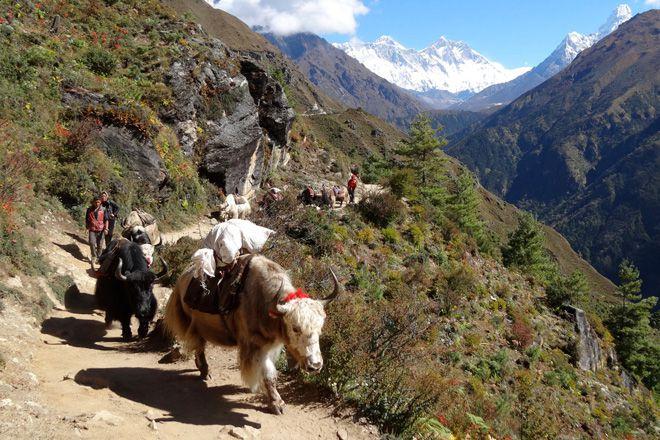Yaks: At Home in the Mountains
Whether you are Mera Peak trekking, hiking up to Everest Base Camp or walking on some of the more remote paths of the Solo Khumbu region, you are bound to encounter yaks in some form.

Yaks on the trail. R Warrick
Indeed, on our Everest Base Camp Trek, we use them as porters, carrying heavy gear up the mountains. The locals put them to similar uses, bearing goods along trade routes or working shorter distances ploughing fields. They are also milked, with yak butter a common foodstuff of the high Himalaya, and the yak itself can be eaten too. Above the tree line, their dung is the only source of fuel for households.
They have a larger heart and lungs than cattle found at lower altitudes, and their blood possesses a greater capacity for transporting oxygen. Reminiscent of other animals adapted to cold environments, they have a thick layer of subcutaneous fat and almost no sweat glands. What little sweating they do also produces a sticky substance that helps to keep their under-hair matted, providing yet another layer of insulation – because, of course, the thick, long over-hair that makes them instantly recognisable is also designed to keep them warm in their often bitterly cold habitats.
Wild yaks still exist, but those you will see while Mera Peak trekking or following the Everest Base Camp route, for instance, will undoubtedly be the domestic variant. These typically graze on grass. Wild yaks' diet also consists of grasses and sedges, but, as well, they eat a smaller amount of herbs, mosses, winterfat shrubs and lichen. Their predators were historically the Tibetan wolf, as well as the snow leopard and brown bears; nowadays, they are also under threat from people, who hunt them for traditional medicine. The wild yaks are considered extinct in Nepal.
Domestic yaks are still around in large numbers, in areas from the southern Himalaya to as far north as Mongolia and Russia, and are quite the sight while up in the mountains, Mera Peak trekking or following one of the other popular trekking routes.
Yaks are incredibly well adapted to high altitude life. Whereas we must acclimatise carefully while Mera Peak trekking or on any other route that takes us thousands of metres above sea level, the yaks are at home. In fact, taking them to low altitude is bad for their health, and they develop heat exhaustion from temperatures of around 15°C (59°F).